
Bob's Studebaker Resource Website
From the SDC Forum - Nov 2013
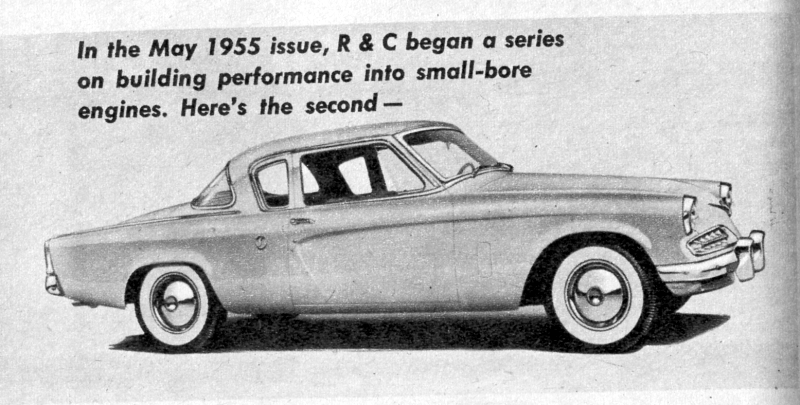
Hopping Up The STUDEBAKER 6
One of the oldest of the small-bore mills still in production is the Studebaker Champion which, until 1955, remained basically unchanged for more than 15 years except for a stroke increase of one quarter inch in 1947. The only major change in ‘55 was a further stroke increase made possible by a much heavier crank which, unfortunately, is not interchangeable with earlier models. At first glance, the Champ is not an inspiring engine; bore and stroke are only 3 by 4 respectively, giving a displacement of 170 inches. Compression is a mild 7 to 1 in the later models and less in the earlier units. Carburetion and manifolding is definitely nothing to shout about. On the credit side of the ledger, though, is a block construction that would put a tractor engine to shame. With this in mind, the aforementioned debits point a way toward a lot of improvement. Since there’s not much point in dreaming up theoretical modifications we’ll use as our example the Morgan equipped ‘53 Champ built by Gordon Mills, of West L. A., Calif. The car was purchased used by Gordon on his emergence from the Army a year ago. The ‘53 and later series Stude chassis has provision made for mounting either the V8 or the Champ so Gordon had a choice; he could go all out and follow the crowd with the bent-eight or he could stay with Stude’s lighter 6 and be real original. He chose the latter route - and wiht a good deal of success. I can attest personally that the harmonized Champ definitely goes! Because boring and stroking is the easy way out and completely fouls up estimates on the value of the other tuning tricks, Gordon left the engine with its original bore and stroke measurements - he can always go bigger later on. Proceeding logically, Gordon went to Frank Morgan’s Marysville, Calif., place of business and asked advice. What he learned follows.
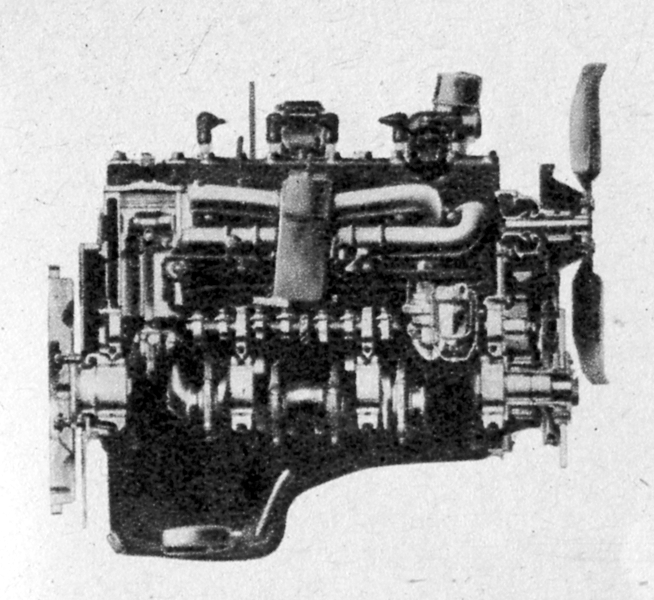 Cutaway of the 1955 Studebaker Champion 6. Though this engine has never been famous for performance, rugged construction makes it a natural as bait. HP can go to 194. 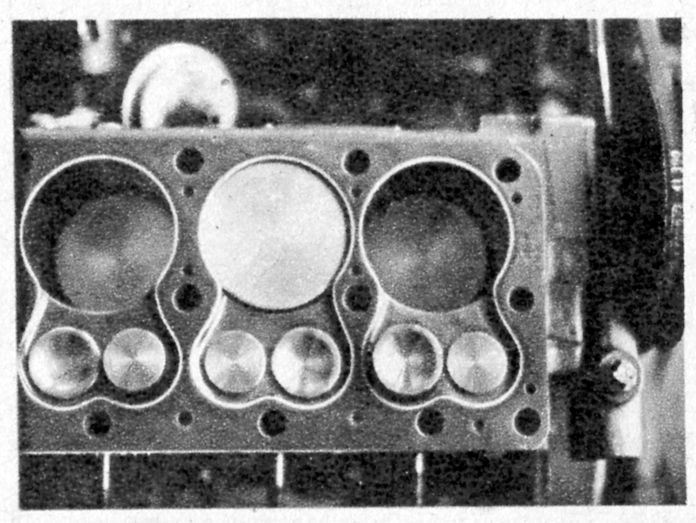 This Champ engine has been bored out to 3-1/8" and fitted with oversize Morgan pistons. The block has been ported, relieved; has oversize intake valves. Valves are “streamlined”. 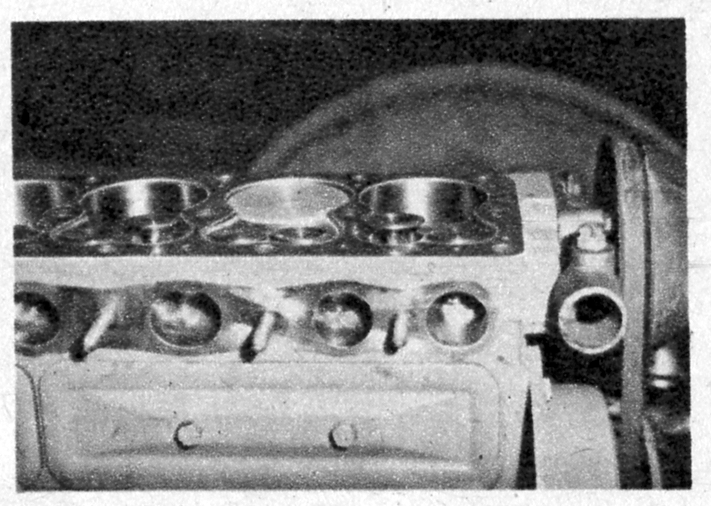 This 3-1/8" bore engine is slated for use in an MG. Note expert relieve job by Morgan Co. 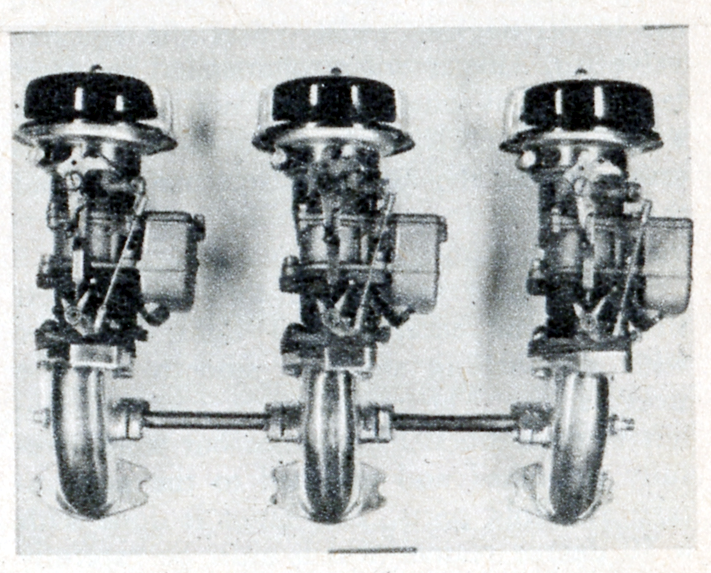 The Morgan Co. offers this set up for out and out competition. Triple “stubbies” mounting #81 Stromberg carburetors, when set for use with methanol on a full race engine, have helped in delivering 194 horses on ‘55 block. Exhaust headers must be used with manifold. Again, with great logic, the starting place in building up the Champ is an increase in compression ratio. The stock head will take a milling job of .070" to produce a comp. Ratio of 7.8 to 1 on an unrelieved block. However, since relieving was planned, a greater boost was necessary. Morgan, Weiand and Edmunds all produce excellent special heads with compression ratios up to and above 8.5 to 1. Other purchases from Morgan included a log-type dual manifold, two matched an reworked carburetors, a cam, a set of matched and lightened valves with springs and a set of special pistons. Total cost of thos items came to a shade over $200 [about $1700 today -WDC] for the whole works, a somewhat lower figure than for a full-house layout for a big 8-hole meat grinder! Starting from the inside and working out, here’s a procedure for using all of the above mentioned special metal.
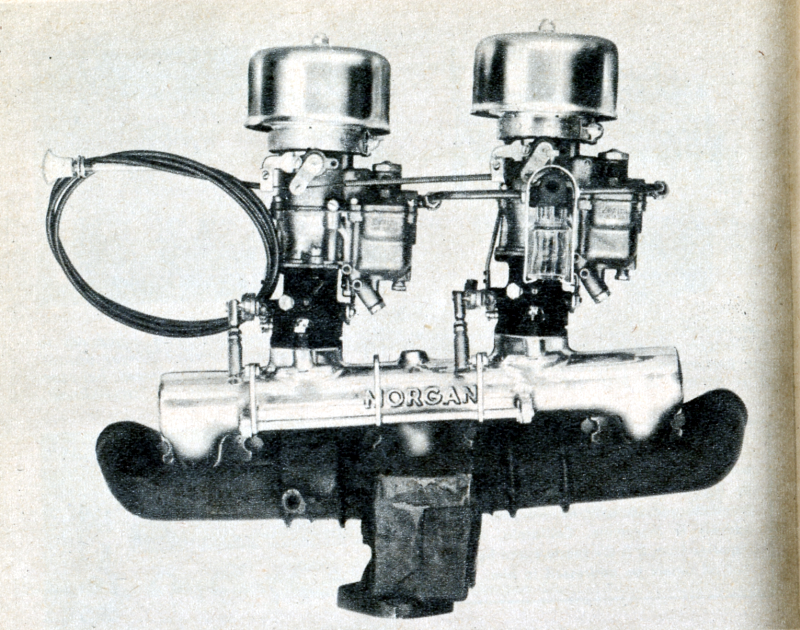 “Heat box” of exhaust manifold must be cut off if this dual setup is used. Upper box section is trimmed off, cavity and other holes brazed shut. Reworked exhaust manifolds are available. The first operation was on the intake valves. The seats and valve pockets are reamed out with either a 70 degree piloted reamer or a 70 degree stone on a die grinder to an i.d. of 1.260" to take a valve of 1-15/32 inches - 1/8" larger than stock. The intake seats are cut to 30 degrees, which raises the effective valve lift. This is not recommended for most larger or ohv engines, particularly those in which hot or racing fuels are used. In this case, though, the car is a street machine and the hottest fuel used will come from the service station pump. The exhaust valves and throats were left strictly alone except for a light once-over with a polishing stone to smooth out the irregularities. The intake ports were likewise left at their stock 1-5/16 inches but were carefully smoothed and matched to the new intake manifold ports. This latter is done with a 70 degree reamer which must be carefully operated by hand since no pilot is used. Another method of accomplishing the same thing is with the use of a 70 degree stone and grinder. All that is required in the way of metal removal is about 1/32 of an inch, if that, so easy does it. The cam used in this particular case was the Morgan H-1000 which, from the duration of 256 degrees and .378" lift, would appear to be somewhat in the hot 3/4 race range. With this cam the intake opens 21 degrees BTDC and closes 55 degrees ABDC; exhaust open 60 degrees BBDC and close 16 degrees ATDC. The cam is still mild enough for street use and yet packs plenty of wallop at the upper end of the rpm scale. About the only noticeable ill effect is a very slight roughness when idle speed drops below 600 rpm. With this cam are used the 30 degree valves mentioned before which are lightened and polished. Special springs are used but these are not appreciable stronger in tension, about 10 lbs. more pressure being all that’s needed to follow the new cam contour. Another point to be brought out here is that the valve guides should be kept at stock height although they can be beveled slightly. If they are chopped or seriously beveled valve heat dissipation will be greatly affected. Since the valves in the Champ are tilted slightly off the vertical as in the Ford flathead, a relieve job is a definite help. Maximum relief in this block is 5/32 fo an inch in depth. Any more would create the possibility of a scorched upper compression ring. 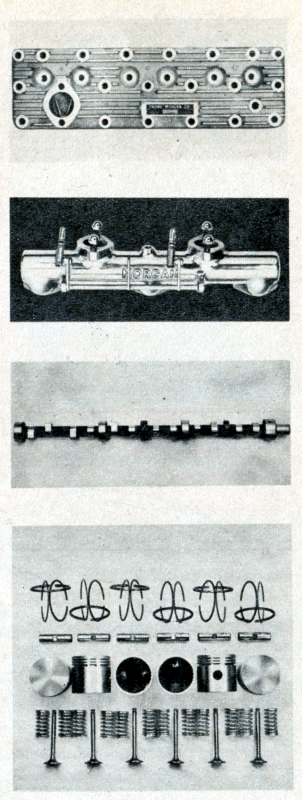 The Morgan Company offers, among many other items for the Stude 6, the above equipment. Economy minded enthusiasts should start by purchasing the head first, then progressing to the manifold, cam and, lastly, the full race setup in the bottom photo. Parts can be purchased separately or as a complete kit. All above parts would run just over $200. The surprisingly small clearance of .003 of an inch can be used in fitting pistons. If hard usage is expected as in all-out competition, however, a clearance of .005" should be considered the minimum. Morgan makes a set of 1/8" oversize pistons which are available in matched and balanced sets with special rings and pins fitted. In Gordon’s case, the pistons were left on the shelf until such time as he feels the need of a few more inches or a rebore becomes necessary. When the engine was torn down the stock pistons, crank, rods, flywheel and clutch were all sent out for dynamic balancing, a necessity with the smaller engines which can, if unbalanced, practically leap out of the car when wound up tight. One of the trickier operations on the Champ is the use of a dual intake manifold. The stock unit is integral with the exhaust manifold and both intake and exhaust sides of this hunk of iron are restricted - probably in the interests of economy although its doubtful what effects such restriction has on raising mileage. Consequently, if it is desired to leave the stock exhaust manifold on the car and use the duals, a sawcut must be made squarely below the floor of the original intake manifold at the heat riser. The closer to the original manifold the cut is made, the less the trimming and fitting that must be done later. The “quick-heating” valve and all its components should be removed and all the holes brazed shut. The heat box is then trimmed so that a close fit may be made with the new aluminum manifold. An easier solution is to buy one of these exhaust manifolds already trimmed to fit. The whole combination is available from Morgan complete with a pair of reworked Zenith Z0X9 carburetors. These when reworked have a smaller venturi. The new unit is made of machined aluminum and is apparently of slightly different shape than the original pot-metal venturi. Exactly how different would have required the sectioning of one and Gordon was somewhat loathe to let me tear into one of his only two. Suffice it to say, though, that the idea is basic; a small venturi area and reasonably rich jetting combine to produce acceleration. For top speed runs, perhaps, it would be best to use the larger venturi area since at peak rpm breathing is all important. In this particular installation it was unnecessary to go through the hassle of butchering the exhaust layout since headers are being used. These are of the split variety, half of the leads going to the forward ports and half to the rear with two outlets and dual pipes. In constructing exhausts for the Champ it should be noted that the smaller the engine the greater effect exhaust tuning will have on performance. One particular note of caution was made in regard to the Champion: under no circumstances should the lead-in pipes to the ports be of larger diameter than that of the port itself. This dimension should remain at port size until the head pipe is reached at which point a gradual increase in diameter can be made. If the lead-in pipes are too large or widen too abruptly much o the scavenging effect of a hot cam will be lost. It is beyond the scope of this particular story to go into this rather fascinating subject but suffice it to say that running a lot of large plumbing out of the ports is not going to get the job done - on any engine. As was pointed out earlier, a stroke change was made in the Champ 6 in 1947. At this time the stroke was lengthened a quarer of an inch and insert bearing type rods substituted for the earlier poured bearings. For those with earlier blocks a double benefit can be made by making a crank switch; you can thereby get the full four-inch stroke and the insert rods at one swoop. It’s unfortunate that the ‘55 crank cant be used since it s a particularly rugged unit with a bearing area large enough for a Cadillac but therein lies the trouble; the mains are a full three inches in diameter and the rod journals are commensurately larger despite a lengthened stroke. Those fortunate enough to have a ‘55 block though can relax and be happy - except for the crank and rods, the same procedures and equipment outlined above will hold true for the ‘55. Unlike the previously covered Willys engine (R & C for May ‘55), it’s doubtful if a blower installation can be readily made on this block without a lot of reworking and mounting. Although this engine would undoubtedly benefit from such an installation there is no readily adaptable kit available to fit a blower to it and, unfortunately, there are few blowers of the proper size, at least as far as positive displacement units go. It’s just possible that the McCulloch centrifugal supercharger could be made to work although, as we said, no kit is available. At any rate, just because that Stude coupe has a placard saying “Champion” on the back, don’t laugh. That Champ may be loaded... for you! Much of the equipment for the Studebaker Champion 6-cylinder engine noted in this article is available through the Frank Morgan Co. only. Mr. Morgan, whose address is Marysville, California, invites inquiries from R & C’s readers and he asks that all letters be addressed to him. |